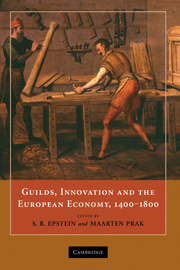Book contents
- Frontmatter
- Contents
- List of Contributors
- Acknowledgments
- Introduction: Guilds, Innovation, and the European Economy, 1400–1800
- 1 Craft Guilds, the Theory of the Firm, and Early Modern Proto-industry
- 2 Craft Guilds, Apprenticeship, and Technological Change in Pre-industrial Europe
- 3 Subcontracting in Guild-based Export Trades, Thirteenth–Eighteenth Centuries
- 4 Circulation of Skilled Labour in Late Medieval and Early Modern Central Europe
- 5 Painters, Guilds, and the Art Market during the Dutch Golden Age
- 6 Craft Guilds and Technological Change: The Engine Loom in the European Silk Ribbon Industry in the Seventeenth and Eighteenth Centuries
- 7 Guilds, Technology, and Economic Change in Early Modern Venice
- 8 Inventing in a World of Guilds: Silk Fabrics in Eighteenth-century Lyon
- 9 ‘Not to Hurt of Trade’: Guilds and Innovation in Horology and Precision Instrument Making
- 10 Reaching beyond the City Wall: London Guilds and National Regulation, 1500–1700
- 11 Guilds in Decline? London Livery Companies and the Rise of a Liberal Economy, 1600–1800
- Index
6 - Craft Guilds and Technological Change: The Engine Loom in the European Silk Ribbon Industry in the Seventeenth and Eighteenth Centuries
Published online by Cambridge University Press: 24 June 2009
- Frontmatter
- Contents
- List of Contributors
- Acknowledgments
- Introduction: Guilds, Innovation, and the European Economy, 1400–1800
- 1 Craft Guilds, the Theory of the Firm, and Early Modern Proto-industry
- 2 Craft Guilds, Apprenticeship, and Technological Change in Pre-industrial Europe
- 3 Subcontracting in Guild-based Export Trades, Thirteenth–Eighteenth Centuries
- 4 Circulation of Skilled Labour in Late Medieval and Early Modern Central Europe
- 5 Painters, Guilds, and the Art Market during the Dutch Golden Age
- 6 Craft Guilds and Technological Change: The Engine Loom in the European Silk Ribbon Industry in the Seventeenth and Eighteenth Centuries
- 7 Guilds, Technology, and Economic Change in Early Modern Venice
- 8 Inventing in a World of Guilds: Silk Fabrics in Eighteenth-century Lyon
- 9 ‘Not to Hurt of Trade’: Guilds and Innovation in Horology and Precision Instrument Making
- 10 Reaching beyond the City Wall: London Guilds and National Regulation, 1500–1700
- 11 Guilds in Decline? London Livery Companies and the Rise of a Liberal Economy, 1600–1800
- Index
Summary
Economic institutions that foster technological innovation and diffusion and enable flexible adaptation to technical change enhance social welfare. In all these respects, early modern craft guilds have not been judged very favourably. It is generally believed that they were devoted to maintaining their members' rents by excluding non-members from the labour market and that they resisted labour-saving technologies. The marginalisation, demise, or abolition of craft guilds was therefore a prerequisite for successful proto-industrial and industrial development. The roughly contemporaneous demise of the craft guilds and rise of industrial manufacturing is seen as conclusive evidence of the restrictive practices and negative welfare effects of craft guilds.
While it is certainly true that craft guilds did oppose technical change under specific circumstances, the point is easily overgeneralised. In most parts of continental Europe, the dissolution of guilds from the late eighteenth century on had political rather than industrial motivations, even though abolition was often justified in economic terms. Arguments by economic historians based on the temporal coincidence between the demise of craft guilds and industrial developments hark back to those eighteenth-century debates and rely on highly aggregated evidence. Establishing a direct causal link between the dissolution of guilds and industrialisation without considering decision making at the level of individual craft guilds runs the risk of incurring an ecological fallacy, that is, of making inferences about individual behaviour on the basis of aggregated data.
- Type
- Chapter
- Information
- Guilds, Innovation and the European Economy, 1400–1800 , pp. 172 - 198Publisher: Cambridge University PressPrint publication year: 2008
- 2
- Cited by

